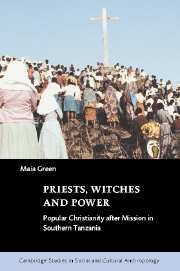Book contents
- Frontmatter
- Contents
- List of maps
- Preface
- 1 Global Christianity and the structure of power
- 2 Colonial conquest and the consolidation of marginality
- 3 Evangelisation in Ulanga
- 4 The persistence of mission
- 5 Popular Christianity
- 6 Kinship and the creation of relationship
- 7 Engendering power
- 8 Women's work
- 9 Witchcraft suppression practices and movements
- 10 Matters of substance
- Notes
- List of references
- Index
- Cambridge Studies in Social and Cultural Anthropology
6 - Kinship and the creation of relationship
Published online by Cambridge University Press: 22 September 2009
- Frontmatter
- Contents
- List of maps
- Preface
- 1 Global Christianity and the structure of power
- 2 Colonial conquest and the consolidation of marginality
- 3 Evangelisation in Ulanga
- 4 The persistence of mission
- 5 Popular Christianity
- 6 Kinship and the creation of relationship
- 7 Engendering power
- 8 Women's work
- 9 Witchcraft suppression practices and movements
- 10 Matters of substance
- Notes
- List of references
- Index
- Cambridge Studies in Social and Cultural Anthropology
Summary
Kinship relationships are not conceptualised as given. Biological relatedness merely creates the potentiality for kinship qualitatively defined. Consequently, claims to kinship and the quality of the content of relationships with kin are potentially negotiable in the public fora where kinship is performatively constituted through ritual and exchange. Decades of migration mean that those to whom a person is related (walongu) are widely dispersed throughout the country. Beyond the idiomatic kinship that characterises neighbourly sociality, the formalisation of kinship relations and their association with specific locales is now a transient artefact of life-crisis rituals. Kinship is dramatised at events associated with marriage and at funerals, where relationships are displayed by such actions as shaving, marking the faces of the relatives of the deceased with flour, the transaction of token payments and the inheritance of property and names. Participation matters, as ‘evidence of kinship’ (Wilson 1957: 200). Payments at funerals and those that make up the marriage process are transacted in cash and are thus highly divisible among those who can present a claim to receiving a portion of them. The sum of money a person receives is less important than the fact that by receiving it they have a legitimate claim to the relationship which receiving a portion of the payment implies. Actual sums obtained by those at the margins of kinship transactions are so small as to be of little economic significance, even to poor households. The value of relationship, however, cannot be overstated.
- Type
- Chapter
- Information
- Priests, Witches and PowerPopular Christianity after Mission in Southern Tanzania, pp. 75 - 90Publisher: Cambridge University PressPrint publication year: 2003



